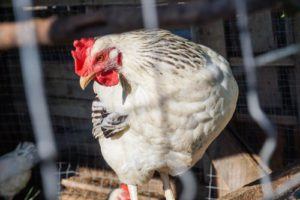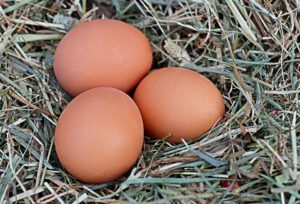Lighting For A Chicken Coop – How Important Is It For Egg Production?
It’s a question many chicken farmers ask each winter…how can I increase light in my coop to keep egg production up? There are a few simple ideas that can be done to your coop to help maximize lighting for a chicken coop and we’ll explore those here.
Adequate lighting is needed to maintain egg production but this gets much more difficult in the winter months when the days are shorter. But there are a few different strategies that can be implemented which are not overly expensive.
Some chicken farmers are not as concerned about a drop in egg production as others, particularly those who just want a few eggs for their own consumption. But for the people who are selling eggs, it becomes a more important topic since you want to have enough eggs each day to keep up with customer demand.
Below we discuss why your lovely hens lay few eggs in the winter, and what can be done to maintain or improve egg production during these seasons.

(Photo by Idella Maeland on Unsplash)
Why Does Egg Production Drop In The Winter
Less light during Fall/Winter
During the long spring/summer days, having adequate light is not a problem. But around September, the days begin to shorten. For maximum egg laying production, your hens will need a minimum of 14 hours of light per day, and many egg producers suggest adding artificial light when it drops to 15 to 16 hours per day. Wikipedia discusses the issue here.
Molting
Your hens will molt yearly. This process involves losing current feathers and growing new ones, sapping a lot of their energy. Because of this, egg production will drop. We’ve owned many flocks of chickens through the years and it’s always a bit frustrating to go through the molt. The molting process lasts a few weeks but it can seem like an eternity while you wait! But just know that egg production will pick up again once the molt is complete.

(By Tyseria [CC BY-SA 3.0 (https://creativecommons.org/licenses/by-sa/3.0)], from Wikimedia Commons)
Cold Weather
The theory behind this factor is that if the temperature is cold, the chickens will expend more energy staying warm and, therefore, will lay fewer eggs. This point is less clear as many chicken farmers living in cold climates still manage to get adequate egg production in the winter if their coop has an adequate amount of light during the shorter winter days.
So how DOES one get their hens to keep up egg production in the colder, darker days of fall and winter? It’s really not too complicated…it’s all about LIGHT!
Adding More Natural Light In Your Coop
By adding an extra window or two, you can greatly increase the amount of natural light in your chicken coop. However, this can be A LOT of work but may be worth it if it’s that or buy a new coop with more windows.
Whether this is feasible or not will depend on the design of your coop but it’s possible to do and may actually be a lot less expensive than buying a new coop with more and/or larger windows.
However – before you start cutting into the walls of your coop, there is another less drastic way to increase light in your coop…
Add Artificial Light In Your Coop
Research has shown that when the amount of natural light drops to below 14 hours per day, egg production will begin to drop. And the shorter the days become, you’ll see fewer eggs in your coop.
Pros And Cons Of Artificial Lighting

(Photo by Kate Remmer on Unsplash)
PROS:
- Egg Production (duh!)
- Warmth for your hens when it gets cold outside since the light used will also provide some heat!
- If you’re selling eggs, you’ll less money by maintaining egg production
CONS:
- Increased Equipment Costs – This involves purchasing lighting supplies like light bulbs, light bulb receptacles, Timer, power cord(s) to plug it in.
- Increased Electrical Costs – With the supplies comes added energy costs as well. However, the wattage of the bulb does not have to be very large so that expense can be minimized to a certain degree.
- Possible Fire Hazard – but that’s more likely to happen if you’re using a heater in your coop.
When To Add Lighting In Your Coop
When to add artificial lighting will depend on where you live geographically, in what climate etc. However, as a general rule you have to gauge it based on when you’re seeing less than 14 hours of natural light during the day.
Obviously there is plenty of natural light coming into the coop during the summer months but this changes in the Fall. Any time beginning in September until around March/April would be the window of time to add the lighting in your coop.
What Time Of Day Should I Turn On The Artificial Lighting
Some chicken farmers like to turn on the artificial lighting at the end of the day to extend the daylight that way. However, the research suggests the best time to add light is early in the morning time, a few hours before the sun comes up.

(Photo by Ashes Sitoula on Unsplash)
Generally speaking, plan about 2- 3 hours of lighting in the coop until the natural daylight appears and “takes over” the rest. Again – you’re aiming for 15-16 hours of good lighting for maximum egg production.
As an example – Where we live, we’d turn on artificial lighting at around 4:30AM and leave it on for 2 1/2 hours. This would be the setting in the dead of winter, like December, when the days are shortest. When the light gets turned off at 7AM, the daylight will provide adequate lighting for the rest of the day.
So continuing with the same example…In late September/early October, the setting could be from 5:00 AM to around 6:30 AM as there is still more daylight available at that time so the light would not have to be used as long each morning as it would during the shortest days of the year in December.
How To Add Lighting In Your Coop
The set up for adding extra light in your coop is really quite simple. It’s just a matter of hanging a light bulb somewhere in your chicken coop! As for placement, it’s best to put it in a place where the entire coop receives the most light. So near the ceiling or roof of the coop would be a great placement as it would light up more of the coop than placing it closer to the floor.
The size of the bulb and type of lighting does not really matter. You can place an incandescent bulb as low as 14 watts in your coop and this will work just fine. Using higher wattage is not necessary and will add to your electric bill. However, some chicken farmers like to use a brooder bulb (like what is used when you are raising chicks) because it will not only provide light, but also a good source of heat.
How To Regulate The Length Of Time The Bulbs Are On
A mechanical timer can be used to regulate when the bulb gets turned on and off. These are not difficult to operate and can be easily adjusted to the start and end times that you set.

(By Zenhydro [CC BY-SA 4.0 (https://creativecommons.org/licenses/by-sa/4.0)], from Wikimedia Commons)
Or simply leave the the light on all the time. I’m not sure about you, but I’d rather spend a few bucks on a timer:)
Timers do not have to be complicated at all. A simple mechanical timer that you can buy from a hardware store or online will work dandy.
The simple models can be set manually with toggle type pegs on the side of the timer. Just plug it in, set the timer for when you want the light to be on, and forget about it!
Other Ways To Maintain Egg Production
In addition to increasing the amount of light needed in your coop, there are a few other ideas out there that are also important to remember when raising hens in the winter.
- High Protein Feed – Chickens (all animals for that matter) need an adequate amount of high protein feed in the winter. For chickens, the protein level should be at around 16% or higher. More about choosing the right kinds of feed for your chickens can be found here.
- Clean Water That Is Not Frozen Solid – Whether it’s hot or cold, water is essential for your chickens.
- A Safe, Well Ventilated Coop – Ventilated does not mean drafty. Proper ventilation means there is adequate air flow so the build up of coop odors/ammonia does not build up. Venting in the top of the coop usually provides perfect venting in both summer and winter seasons.
Final Thoughts
I hope you’ve learned all you need to know about chicken coop lighting here. I have used artificial light in the past and have seen positive results first hand. The set up I used was a brooder light receptacle with a 20 watt red colored light bulb. My egg production stayed up and it didn’t break the bank!

(Photo By Couleur, Pixabay)
But that was a few years ago when we were selling eggs on a roadside stand. Now, we are just feeding our family and I no longer add any lighting in our coop.
We have a new group of hens again this year and they are laying strong so far…but as winter approaches I fully anticipate a dip in egg production but I’m okay with it this time!
I’ve made sure my coop is properly winterized and that they’re getting fresh water and plenty of feed. (For more on getting your coop ready for Winter, read here.)
Although the number of eggs we’ll get this Winter will be less, I know we’ll get a few for the family and that’s good enough for me!
Depending on your situation, you’ll have to decide if adding light in your coop is worth it or not. It’s a bit more work, but if you need or want more eggs, it just might be worth it!
Please comment if you have ever tried using light in your chicken coop, or are thinking about giving it a go. We’d love to hear from you so please leave a comment below! Thanks for stopping by.







